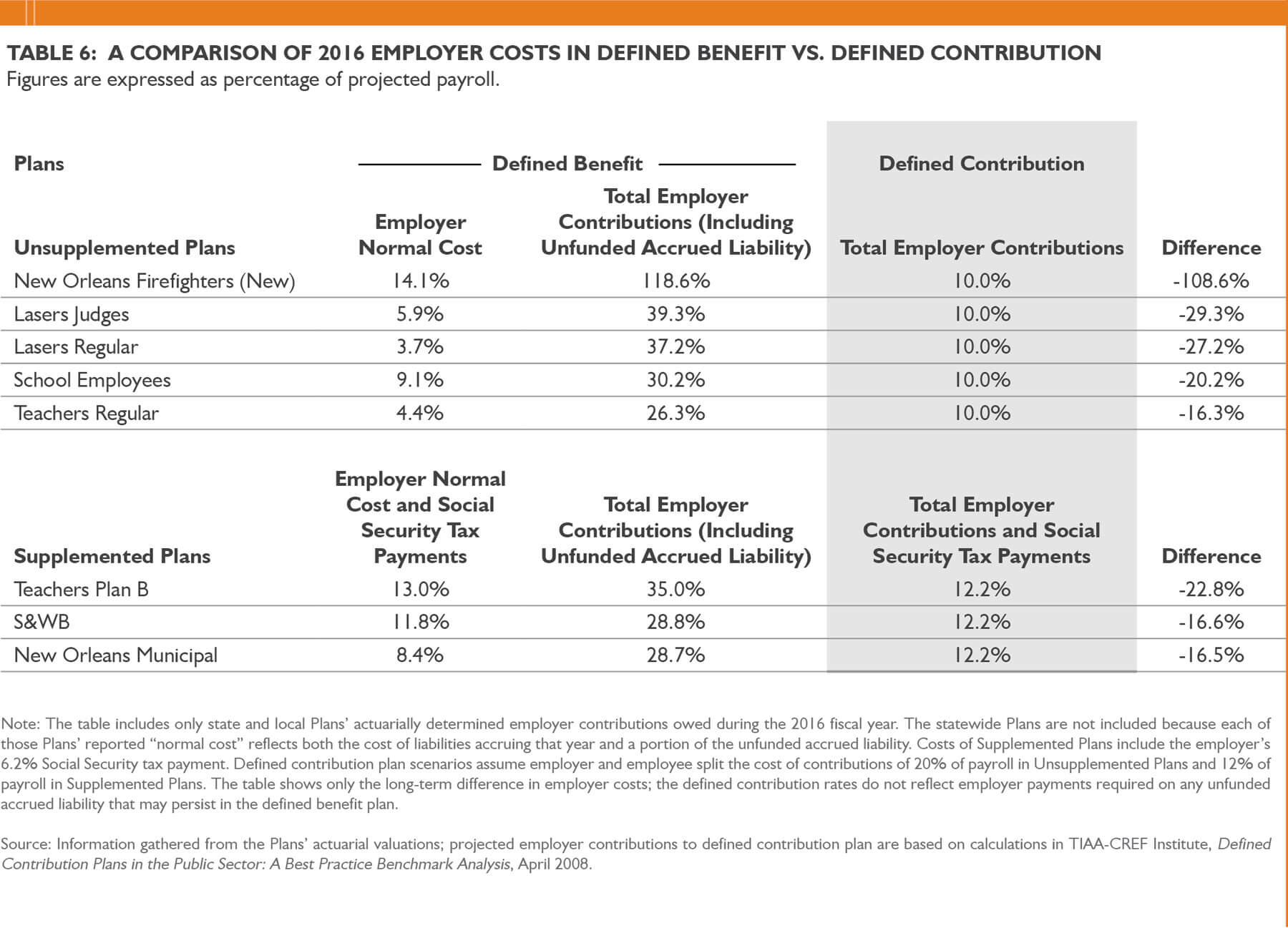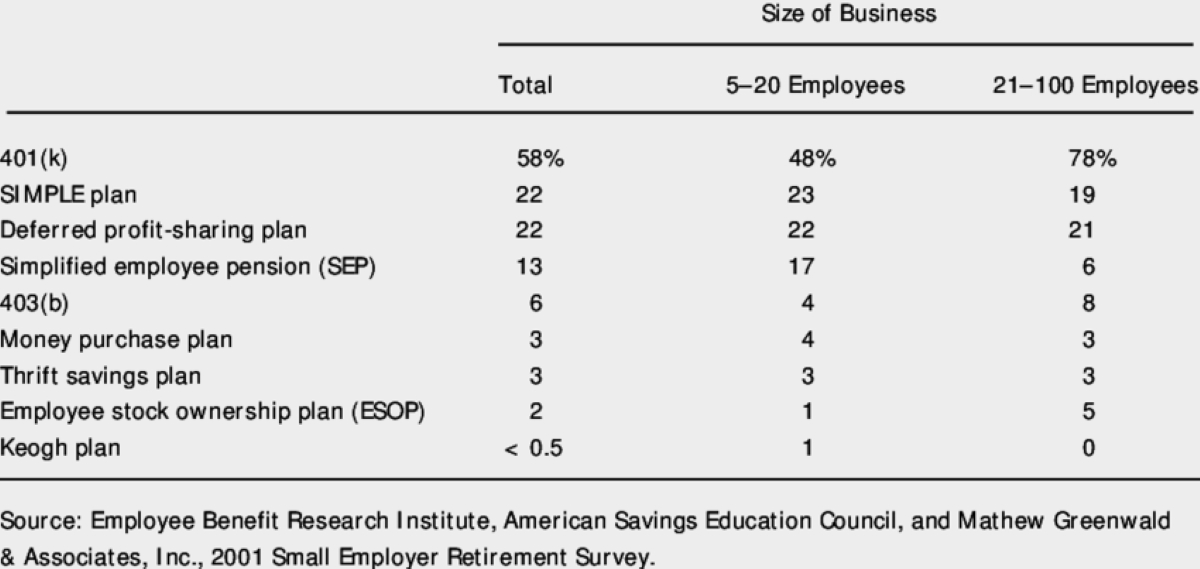Home>Finance>Why Have Employers Moved From Defined Benefit To Defined Contribution Plans


Finance
Why Have Employers Moved From Defined Benefit To Defined Contribution Plans
Published: January 2, 2024
Learn why many employers in the finance industry have shifted from offering defined benefit plans to defined contribution plans.
(Many of the links in this article redirect to a specific reviewed product. Your purchase of these products through affiliate links helps to generate commission for LiveWell, at no extra cost. Learn more)
Table of Contents
Introduction
Retirement planning has undergone significant changes over the years, with employers transitioning from traditional defined benefit plans to defined contribution plans. This shift has had a profound impact on both employees and employers, reshaping the landscape of retirement savings.
Defined benefit plans were the norm for many decades, offering retired employees a guaranteed income for life based on a formula that took into account factors such as salary and years of service. However, in recent years, employers have increasingly moved away from these pension-style plans in favor of defined contribution plans.
Defined contribution plans, such as 401(k) plans in the United States, place the responsibility of retirement savings on the individual employee. Rather than guaranteeing a specific retirement benefit, these plans allow employees to contribute a portion of their salary to an investment account, with the employer often providing matching contributions.
This article will explore the reasons behind the shift from defined benefit plans to defined contribution plans, the advantages and disadvantages of defined contribution plans, and the impacts on both employees and employers.
Defined Benefit Plans
Defined benefit plans, often referred to as traditional pension plans, provide employees with a pre-determined retirement income based on a formula that considers factors such as salary, years of service, and age at retirement. These plans are typically funded by the employer, who is responsible for managing the investments and ensuring that there are sufficient funds to meet future benefit obligations.
Under a defined benefit plan, employees have the peace of mind of knowing that they will receive a fixed income throughout their retirement years. This guaranteed income can provide financial security and stability, especially for those who may not be well-versed in managing their own investments.
One of the main advantages of defined benefit plans is that the investment risk is borne by the employer. Employees do not have to worry about market fluctuations or making investment decisions; they simply receive their promised retirement income. This can be particularly beneficial during times of economic uncertainty.
However, defined benefit plans also come with their drawbacks. The cost of administering and funding these plans can be substantial for employers, as they are responsible for ensuring that there are sufficient assets to cover future benefit payouts. This includes making regular contributions to the plan and managing investment returns.
In addition, defined benefit plans require long-term commitments from employers, as they are obligated to provide retirement benefits to employees over many years. This can be challenging for companies facing financial difficulties or those that operate in industries with high turnover rates.
Overall, defined benefit plans have been a traditional and reliable form of retirement savings. However, the landscape has shifted in recent years, with employers increasingly opting for defined contribution plans. The transition to these plans has been driven by a variety of factors, which will be explored in the following section.
Defined Contribution Plans
Defined contribution plans, such as 401(k) plans in the United States, have gained popularity as a modern alternative to defined benefit plans. In these plans, employees are responsible for contributing a portion of their salary to an individual investment account, which is typically managed by a financial institution. Employers often provide a matching contribution, up to a certain percentage, to incentivize employee participation.
Unlike defined benefit plans, the ultimate retirement benefit in a defined contribution plan is not predetermined. Instead, it depends on factors such as employee contributions, investment performance, and the length of time the funds are invested.
With defined contribution plans, employees have more control over their retirement savings. They can choose how much to contribute and have the flexibility to adjust their contributions over time. They also have the freedom to select investment options that align with their risk tolerance and financial goals.
This shift towards individual responsibility for retirement savings is seen as a response to the changing landscape of employment. The traditional model of lifelong employment and a secure pension from a single employer has given way to more fluid job markets and increased mobility. Defined contribution plans provide employees with portable retirement savings that can move with them from one job to another.
Another advantage of defined contribution plans is the potential for tax-deferred growth. Contributions made to these plans are often made with pre-tax dollars, which can lower an employee’s taxable income. Additionally, any investment gains within the account are not subject to capital gains taxes until withdrawals are made during retirement.
While defined contribution plans offer increased flexibility and control for employees, they also come with some challenges. The burden of investment decisions and market fluctuations falls on the individual. This requires employees to have a basic understanding of investment principles or seek professional advice to ensure their retirement savings grow as intended.
Overall, defined contribution plans have become a widely adopted retirement savings vehicle, offering employees greater control over their financial future. However, it’s important to consider both the advantages and disadvantages when evaluating these plans in the context of retirement planning.
Reasons for the Shift from Defined Benefit to Defined Contribution Plans
The transition from defined benefit plans to defined contribution plans has been driven by a combination of factors. These reasons have influenced employers to rethink their retirement benefit offerings and shift the responsibility of retirement savings to employees. Below are some of the key drivers behind this shift:
- Rising Costs: Defined benefit plans have become increasingly expensive for employers to administer and fund. The longevity of employees, economic volatility, and changes in the regulatory landscape have all contributed to rising costs. As a result, many employers have sought cost-effective alternatives, such as defined contribution plans, where the burden of funding retirement benefits is shifted to the individual.
- Financial Risk Mitigation: Defined benefit plans expose employers to significant financial risks. Fluctuations in investment returns and increased life expectancies can create funding shortfalls and add financial strain to companies. By transitioning to defined contribution plans, employers can mitigate these risks and transfer the responsibility of investment performance and longevity risk to employees.
- Flexibility and Portability: In today’s dynamic job market, employees are more likely to change jobs multiple times throughout their careers. Defined contribution plans offer flexibility and portability, allowing employees to carry their retirement savings with them from one employer to another. This mobility aligns with the modern workforce’s need for adaptable retirement plans that can accommodate changing employment situations.
- Individual Empowerment: Defined contribution plans empower individuals to take charge of their retirement savings. Employees have control over how much they contribute and the investment options they choose. This shift towards individual responsibility aligns with the paradigm shift from paternalistic employer-provided pensions to a more self-directed approach to retirement planning.
- Employee Preferences: With the increase in financial literacy and a growing expectation of personal financial responsibility, some employees prefer defined contribution plans. These plans offer transparency, flexibility, and the potential for increased financial rewards based on their own contributions and investment choices. Employees appreciate the ability to tailor their retirement savings approach to their unique goals and risk tolerance.
While the shift to defined contribution plans has been driven by these factors, it is important to note that not all employers have entirely phased out defined benefit plans. Some companies still offer hybrid plans or provide the option for employees to choose between defined benefit and defined contribution plans based on their individual preferences.
Overall, the move from defined benefit to defined contribution plans reflects a changing landscape in retirement planning, where employers seek cost-effective alternatives and employees desire more control over their financial futures.
Advantages of Defined Contribution Plans
Defined contribution plans, such as 401(k) plans, offer several advantages for both employees and employers. These advantages have contributed to the growing popularity of defined contribution plans as a preferred method of retirement savings. Below are some key advantages:
- Flexibility and Control: One of the main advantages of defined contribution plans is the flexibility and control they provide to employees. Individuals can choose how much they contribute to their retirement account, often with the option to adjust their contribution rate over time. This flexibility allows employees to align their savings with their changing financial circumstances and retirement goals.
- Portability: Defined contribution plans are typically portable, meaning employees can carry their retirement savings with them when they leave a job. This is particularly beneficial in today’s mobile job market, where employees may change jobs more frequently. Portability ensures that retirement savings are preserved and can continue to grow, regardless of changes in employment.
- Company Matching Contributions: Many employers offer matching contributions as an incentive for employees to participate in their defined contribution plans. This means that for every dollar an employee contributes, the employer contributes a certain percentage, often up to a specified limit. This matching contribution is essentially free money and can significantly boost an employee’s retirement savings.
- Tax Advantages: Defined contribution plans offer several tax advantages. Contributions to these plans are often made with pre-tax dollars, meaning that the amount contributed is not subject to income tax at the time of contribution. Additionally, the investment gains within the account are tax-deferred, allowing for potential growth on a tax-advantaged basis. Taxes are typically paid when withdrawals are made during retirement when the employee may be in a lower tax bracket.
- Employee Empowerment: Defined contribution plans empower employees to take an active role in their retirement planning. They have the opportunity to choose from a range of investment options based on their risk tolerance and investment preferences. This sense of ownership and involvement can lead to a greater sense of financial literacy and engagement in long-term financial planning.
- Transparency: Defined contribution plans offer transparency regarding the value of the account and the contributions made. Employees can easily track the growth of their retirement savings and have a clear understanding of their account balances. This transparency fosters trust and helps individuals make informed decisions about their retirement planning.
Overall, defined contribution plans offer flexibility, portability, tax advantages, and empowerment to employees. These plans have become an attractive option for individuals seeking control over their retirement savings and are often seen as a valuable benefit offered by employers.
Disadvantages of Defined Contribution Plans
While defined contribution plans offer many advantages, there are also some disadvantages that need to be considered. These drawbacks can impact both employees and employers. Here are some key disadvantages of defined contribution plans:
- Investment Risk: With defined contribution plans, employees are responsible for making investment decisions or selecting from a range of investment options provided by the plan. This exposes individuals to investment risk, as the performance of their chosen investments will directly impact the growth of their retirement savings. Market volatility and poor investment choices can lead to significant fluctuations in account balances.
- Uncertain Retirement Income: Unlike defined benefit plans, which provide a guaranteed income for life, defined contribution plans do not offer certainty regarding retirement income. The ultimate retirement benefit depends on various factors such as investment performance, contribution rates, and the length of time the funds are invested. This uncertainty can create anxiety for individuals who are unsure if their savings will be sufficient to support their desired lifestyle during retirement.
- Responsibility and Complexity: Employees bear the responsibility of managing their own retirement savings in defined contribution plans. This can be overwhelming for individuals who lack knowledge and experience in finance and investing. Making complex investment decisions and staying informed about market trends can be challenging for those without a strong financial background.
- Limited Employer Contributions: While matching contributions from employers are a significant advantage, not all employers provide generous or equal matching contributions. Some companies may set limits on matching contributions or provide lower matching rates. This can result in a missed opportunity for employees to maximize their retirement savings and take full advantage of the potential employer contributions.
- Fee Structure: Defined contribution plans often come with administrative fees and investment management fees. These fees can reduce the overall returns for employees over time. It’s essential for individuals to carefully review the fee structure of their plan and select investment options with reasonable fees to optimize their retirement savings.
- Inadequate Savings: Defined contribution plans place the onus of contributing to retirement savings on the employee. Unfortunately, not all individuals contribute enough to meet their retirement goals. Many people struggle to save adequately due to various reasons, such as competing financial priorities or unexpected financial hardships. Insufficient savings can result in a shortfall in retirement income and potentially delay the retirement plans of individuals.
While defined contribution plans offer flexibility and individual control, it’s important for employees to be aware of the potential disadvantages and take necessary steps to mitigate them. Regularly reviewing investment choices, seeking financial guidance, and saving diligently can help employees navigate the challenges associated with these plans.
Impact on Employees
The shift from defined benefit to defined contribution plans has had a significant impact on employees and their retirement savings. Here are some key impacts of this transition:
- Increased Individual Responsibility: With defined contribution plans, employees have the responsibility of managing their retirement savings. This places a greater burden on individuals to make informed investment decisions, contribute regularly, and monitor their account balance. Employees must take an active role in their financial planning, educating themselves about retirement savings and seeking financial advice when needed.
- Flexible Retirement Planning: Defined contribution plans offer employees more flexibility in retirement planning. Individuals have the ability to adjust their contributions based on their financial situation and retirement goals. The portability of these plans also allows employees to carry their retirement savings from one job to another, providing greater flexibility in career decisions and transitions.
- Personalized Investment Strategies: Employees have the opportunity to personalize their investment strategies based on their risk tolerance and investment preferences. This level of customization allows individuals to tailor their investments to align with their long-term goals. However, it also requires employees to have a basic understanding of investment principles or seek professional advice to make informed investment decisions.
- Retirement Income Uncertainty: Unlike defined benefit plans, which provide a guaranteed income stream in retirement, defined contribution plans do not offer the same level of certainty. The ultimate retirement benefit depends on various factors, including investment performance and contribution rates. Employees may need to carefully manage their retirement savings, withdrawals, and investment strategies to ensure a sustainable income stream during retirement.
- Financial Empowerment: Defined contribution plans empower individuals to take control of their financial future and actively participate in their retirement planning. Employees have the ability to track their account balance, monitor investment performance, and make adjustments as needed. This sense of ownership and empowerment can increase financial literacy and engagement in long-term financial planning.
- Varying Retirement Outcomes: The transition to defined contribution plans means that retirement outcomes can vary significantly among employees. The level of investment returns, contribution rates, and timing of withdrawals can result in varying retirement income levels. Individuals who actively manage their retirement savings and make sound investment decisions may experience more favorable outcomes compared to those who do not actively engage in their financial planning.
Overall, the impact on employees has been a mix of increased responsibility, flexibility, and empowerment. While defined contribution plans offer individuals more control over their retirement savings, it is crucial for employees to take an active role in managing their accounts and seek the necessary financial education and guidance to make informed decisions.
Impact on Employers
The shift from defined benefit to defined contribution plans has also had a significant impact on employers. Here are some key impacts of this transition:
- Reduced Financial Liability: Defined contribution plans have helped employers reduce their financial liability compared to defined benefit plans. With defined benefit plans, employers are responsible for ensuring that there are sufficient funds to meet future benefit obligations. Shifting to defined contribution plans transfers the investment and longevity risks to employees, reducing the long-term financial burden on employers.
- Cost Predictability: Defined contribution plans offer employers more cost predictability than defined benefit plans. With defined benefit plans, employers must contribute regularly to fund future benefit obligations, which can be unpredictable due to factors such as changing demographics and investment performance. Defined contribution plans eliminate the need for these ongoing contributions and provide employers with more clarity around retirement benefit costs.
- Administrative Simplicity: Defined contribution plans are generally easier to administer compared to defined benefit plans. The administrative complexities of managing investments, calculating benefit formulas, and ensuring regulatory compliance are significantly simplified with defined contribution plans. This reduces the administrative burden on employers, allowing them to focus on their core business operations.
- Flexibility in Benefit Offerings: Defined contribution plans offer employers flexibility in designing retirement benefits. Employers can choose from a range of plan options and contribution structures to meet the needs of their workforce and align with their budgetary constraints. This flexibility allows employers to customize retirement benefits based on factors such as company size, industry, and employee demographics.
- Employee Attraction and Retention: Defined contribution plans can be an attractive employee benefit, particularly in a competitive job market. Offering a retirement savings plan demonstrates an employer’s commitment to supporting employees’ long-term financial well-being. It can also help attract and retain top talent, as employees often consider retirement benefits as an essential factor when evaluating job opportunities.
- Enhanced Employee Engagement: The shift to defined contribution plans has the potential to increase employee engagement in retirement savings. With defined contribution plans, employees have more control over their retirement savings and are actively involved in making investment decisions. This engagement can translate into improved financial literacy and planning among employees, leading to better overall employee financial wellness.
While the transition to defined contribution plans has its advantages for employers, it is important to note that proper plan administration and communication are crucial. Employers must ensure that they provide adequate education and support to employees to make informed decisions about their retirement savings, as the success of defined contribution plans hinges on employee participation and effective plan management.
Conclusion
The shift from defined benefit to defined contribution plans has transformed the landscape of retirement savings, impacting both employees and employers. This transition has been driven by various factors, including rising costs, financial risk mitigation, flexibility, and individual empowerment.
Defined contribution plans offer advantages such as flexibility, portability, employer matching contributions, tax benefits, employee empowerment, and transparency. Employees have more control over their retirement savings and the ability to personalize their investment strategies. However, there are also disadvantages to consider, including investment risk, uncertain retirement income, responsibility and complexity, limited employer contributions, fees, and the potential for inadequate savings.
On the employer side, the shift to defined contribution plans reduces financial liability, provides cost predictability, simplifies administrative processes, offers flexibility in benefit offerings, and enhances employee attraction and engagement. However, employers must ensure proper plan administration and communication to maximize the benefits of defined contribution plans.
In conclusion, the transition from defined benefit to defined contribution plans reflects the changing dynamics of retirement planning, where employees are given more individual responsibility and choice. While defined contribution plans provide flexibility and control, it is essential for employees to actively engage in managing their retirement savings, seek financial education when needed, and make informed decisions to achieve their desired retirement goals.
Ultimately, the shift to defined contribution plans represents a paradigm shift in retirement planning, allowing individuals to take ownership of their financial future and shape their retirement according to their unique needs and aspirations.














